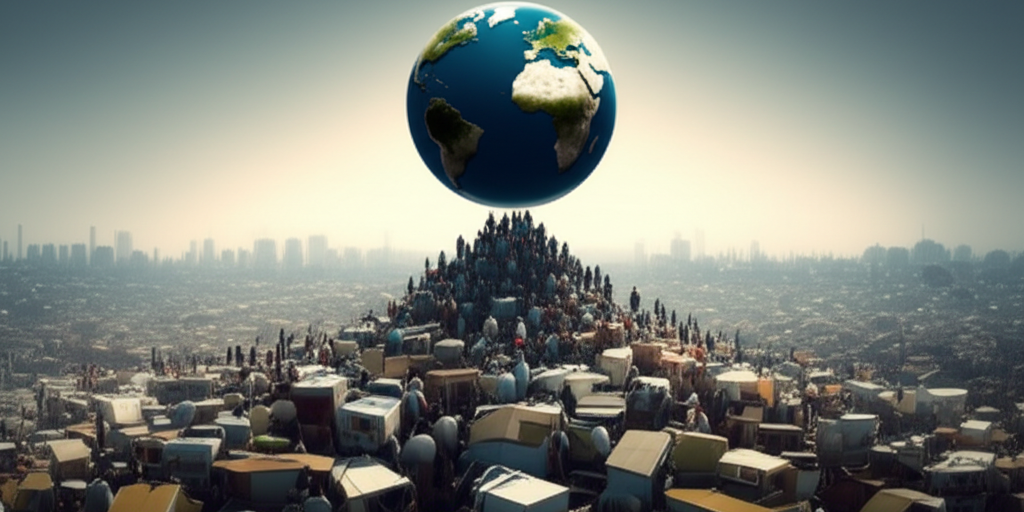The Ripple Effect: Understanding the Ill Effects of Overpopulation

The Ripple Effect: Understanding the Ill Effects of Overpopulation
The world's population has grown at an unprecedented rate, soaring to over 7.9 billion people as of 2023. While this growth is a testament to human adaptability, it has also given rise to a complex web of challenges, collectively known as the "ill effects of overpopulation." These far-reaching consequences impact our environment, economy, and social fabric, creating significant concerns for the planet's carrying capacity – the maximum number of individuals an environment can sustainably support indefinitely.
Environmental Degradation: A Heavy Footprint
Overpopulation places an immense and unsustainable strain on natural ecosystems, leading to widespread environmental degradation. The increasing number of people translates directly into heightened demand for resources and increased waste generation, with profound impacts on our planet.
Resource Depletion
More people require more food, water, energy, and other resources for survival, leading to their depletion.
- Water Scarcity: Demand for freshwater has surged, increasing by 600% globally for domestic use between 1970 and 2020. This escalating demand exacerbates water scarcity, with predictions that global demand for freshwater will exceed supply by 40% by 2030.
- Arable Land Degradation: The growing population intensifies the strain on global food security, pushing agricultural systems to their limits. This leads to widespread soil degradation and the loss of fertile land. Approximately 33% of global arable land is already degraded.
- Energy Consumption: Larger populations demand more energy, primarily from fossil fuels. This increased consumption contributes to greater greenhouse gas emissions, accelerating climate change.
Biodiversity Loss and Habitat Destruction
Overpopulation is a major driver of biodiversity loss, often referred to as a "key obstacle" to fairly sharing habitat and resources with other species.
- Habitat Loss: The need for more housing, infrastructure, and agricultural land directly leads to the destruction of natural habitats. Wild landscapes are replaced with human settlements, agricultural fields, and supporting economic systems. Since 1970, global wildlife populations have declined by an average of 68%.
- Overexploitation: Beyond habitat destruction, overexploitation of wild species, such as overfishing, depletes wildlife to dangerously low levels. Freshwater fish populations, for instance, declined by 83% between 1970 and 2014.
- Pollution and Climate Change: Increased human activity and consumption generate more waste and pollution, including air and water contamination. This exacerbates climate change, with deforestation alone accounting for approximately 10% of global greenhouse gas emissions.
Economic Strain: A Burden on Development
The economic implications of overpopulation are significant, affecting both developed and developing nations.
Increased Poverty and Unemployment
When population growth outpaces economic development, it can lead to higher rates of poverty and unemployment.
- Competition for Resources: A surge in population leads to increased competition for jobs, housing, and other essential resources. This can result in lower wages and income inequality.
- Strain on Public Services: Governments struggle to provide adequate services like healthcare, education, and transportation to a burgeoning population, especially in developing countries. This strains public finances and can reduce the quality of life.
Food and Water Insecurity
The demand for food and water intensifies with a growing population, making it difficult to ensure equitable access.
- Food Shortages: Overpopulated areas often struggle to produce enough food, leading to shortages, higher prices, and food insecurity, particularly in vulnerable populations. Over 820 million people worldwide suffer from chronic hunger.
- Water Crises: The increased demand for water exacerbates existing water stress in many regions, leading to inadequate access to clean water.
Social Challenges: Erosion of Well-being
Overpopulation also creates a myriad of social challenges, impacting the quality of life and fostering societal unrest.
Overcrowding and Inadequate Infrastructure
High population densities in urban areas put immense pressure on existing infrastructure and services.
- Housing Shortages: Overpopulation leads to overcrowding and a lack of resources for adequate housing, a problem particularly acute in developing countries.
- Strained Public Services: Urban areas face overwhelmed healthcare and educational systems, congested transportation, and insufficient access to basic services like sanitation and electricity. The growth of megacities further amplifies these challenges.
Increased Social Tensions and Conflict
The competition for limited resources can create friction within communities and between nations.
- Resource Conflicts: Water disputes, competition for fertile land, or struggles over energy sources can emerge as resources become scarcer.
- Social Inequalities: Disparities in access to education, healthcare, and employment opportunities can intensify social inequalities, fostering resentment and frustration.
Public Health Risks
Densely populated areas are more susceptible to the rapid spread of infectious diseases due to close human contact and inadequate sanitation facilities. The strain on healthcare systems can also make it difficult to provide quality care.
Conclusion: A Call for Sustainable Solutions
The ill effects of overpopulation are undeniable and interconnected, posing significant threats to our planet and human well-being. From environmental degradation and resource depletion to economic strain and social unrest, the challenges are multifaceted and require urgent attention. Recognizing the critical linkages between human population growth and environmental health is paramount. Addressing this complex issue necessitates a comprehensive and coordinated approach that prioritizes population stability as a cornerstone of international and domestic policy. This includes empowering women and girls through education and reproductive health services, promoting family planning, and fostering sustainable consumption patterns. By understanding these profound impacts and working towards sustainable solutions, we can strive to achieve a harmonious balance between human development and the Earth's carrying capacity for current and future generations.

